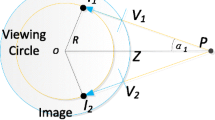Abstract
We study 3D retinal surface reconstruction by using an affine camera due to two following reasons: (1) NIH’s retinal imaging protocols specify a narrow field of view and (2) each retinal image has small depth variation. Specifically, we incorporate the prior knowledge of human retina geometry in the reconstruction process, and introduce a point-based approach to estimate the retinal spherical surface. We also show that lens distortion removal and affine bundle adjustment improve the reconstruction error in terms of the deviation from the underling spherical surface. Simulation results on both synthetic data and real images show the effectiveness and robustness of the proposed algorithm.
Preview
Unable to display preview. Download preview PDF.
Similar content being viewed by others
References
Deguchi, K., Kawamata, D., Mizutani, K., Hontani, H., Wakabayashi, K.: 3d fundus shape reconstruction and display from stereo fundus images. IEICE Trans. Inf. & Syst. E83-D, 1408–1414 (2000)
Deguchi, K., Noami, J., Hontani, H.: 3d fundus pattern reconstruction and display from multiple images. In: IEEE Int’l conference on Pattern Recognition, vol. 4, pp. 94–97 (2000)
Choe, T., Cohen, I., Medioni, G.: 3-d shape reconstruction of retinal fundus. In: Proc. IEEE Conference on Computer Vision and Pattern Recognition, vol. 2, pp. 2277–2284 (2006)
Chanwimaluang, T., Fan, G.: Hybrid retinal image registration. IEEE Trans. Information Technology in Biomedicine 10, 129–142 (2006)
Zhang, Z.: Flexible camera calibration by viewing a plane from unknown orientations. In: IEEE Int’l Conference on Computer Vision, vol. 1, pp. 666–673 (1999)
Koenderink, J.J., Van Doorn, A.J.: Affine structure from motion. Journal of Optical Society of America 8, 377–385 (1991)
Quan, L., Mohr, R.: Towards structure from motion for linear features through reference points. In: IEEE Workshop on Visual Motion, pp. 249–254 (1991)
Demey, S., Zisserman, A., Beardsley, P.: Affine and projective structure from motion. In: Proc. British Machine Vision Conference (BMVC), pp. 49–58 (1992)
Shapiro, L.S.: Affine Analysis of Image Sequences. PhD thesis, Sharp Laboratories of Europe, Oxford, UK (1995)
Tomasi, C., Kanade, T.: Shape and motion from image streams under orthography: A factorization method. Intl. Journal of Computer Vision 9, 137–154 (1992)
Triggs, B., McLauchlan, P., Hartley, R., Fitzgibbon, A.: Bundle adjustment: A modern synthesis. In: Vision Algorithms: Theory And Practice. Springer, Heidelberg (2000)
Hartley, R., Zisserman, A.: Multiple View Geometry in Computer Vision, 2nd edn. Cambridge University Press, Cambridge (2003)
Tresadern, P., Reid, I.: Uncalibrated and unsynchronized human motion capture: a stereo factorization approach. In: IEEE Conference on Computer Vision and Pattern Recognition CVPR, vol. 1, pp. 128–134 (2004)
Weinshall, D., Tomasi, C.: Linear and incremental acquisition of invariant shape models from image sequences. In: IEEE Proc. of 4th Int’l Conference on Computer Vision, vol. 17, pp. 512–517 (1993)
Weinshall, D., Tomasi, C.: Linear and incremental acquisition of invariant shape models from image sequences. IEEE Trans. pattern Anal. Machine Intell. PAMI 17, 512–517 (1995)
Poleman, C.J., Kanade, T.: A paraperspective factorization method for shape and motion recovery. In: Proc. of 3rd European Conference on Computer Vision, pp. 97–108 (1994)
Poleman, C.J., Kanade, T.: A paraperspective factorization method for shape and motion recovery. IEEE Trans. Pattern and Machine Intelligent 19, 206–218 (1997)
Quan, L.: Self-calibration of an affine camera from multiple views. International Journal of Computer Vision 19, 93–110 (1996)
Kurata, T., Fujiki, J., Sakaue, K.: Affine epipolar geometry via factorization method. In: Proc. of 14th Int’l Conference on Pattern Recognition, vol. 1, pp. 862–866 (1998)
Author information
Authors and Affiliations
Editor information
Editors and Affiliations
Rights and permissions
Copyright information
© 2006 Springer-Verlag Berlin Heidelberg
About this paper
Cite this paper
Chanwimaluang, T., Fan, G. (2006). Affine Camera for 3-D Retinal Surface Reconstruction. In: Bebis, G., et al. Advances in Visual Computing. ISVC 2006. Lecture Notes in Computer Science, vol 4292. Springer, Berlin, Heidelberg. https://doi.org/10.1007/11919629_3
Download citation
DOI: https://doi.org/10.1007/11919629_3
Publisher Name: Springer, Berlin, Heidelberg
Print ISBN: 978-3-540-48626-8
Online ISBN: 978-3-540-48627-5
eBook Packages: Computer ScienceComputer Science (R0)




